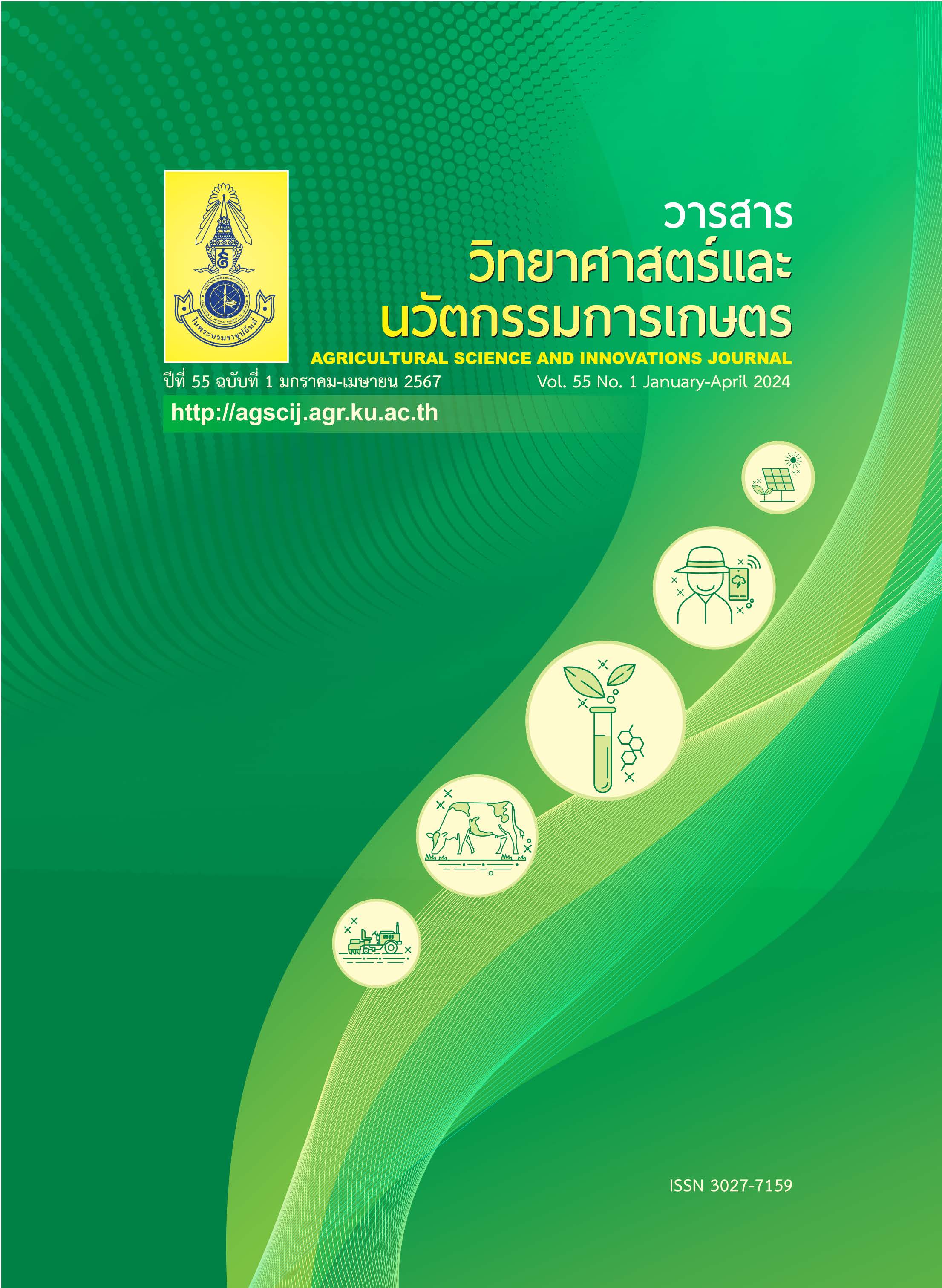Forecasting Rice Yields in Thailand with the AquaCrop Model
Main Article Content
Abstract
Background and Objectives: Rice is a staple economic crop in Thailand, but calamities induced by climate change, such as drought and flooding, are admonishing productivity. Therefore, the goal of this study is to predict future rice yields, enabling farmers to prepare for agricultural adaptation.
Methodology: This study used 2019 farmer data as a baseline year. It was then analyzed with daily climate databased on six parameters: minimum and maximum temperature, precipitation, wind speed, relative humidity, and solar radiation. The study incorporated future climate simulation data from the PRECIS model and considers economic development (A2) and environmentally sustainable development (B2). The data was then statistically analyzed using a Least Significant Difference (LSD) at a 95% confidence level. The accuracy of the AquaCrop model was tested by calculating the Mean Absolute Percent Error (MAPE), comparing the actual yield with the predicted yield for 2020 and 2021. The MAPE values were -0.10% in A2 and -0.04% in B2, with lower values indicating higher accuracy.
Main Results: In the reference year, the average rice yield was 562.24 kg/rai. Future production was then forecasted. In 2030, scenarios A2 and B2 show an increase compared to the base year, with average yield of 646.00 and 600.77 kg/rai, respectively. In 2060, there is also a tendency for an increase, with average yields of 668.95 and 669.16 kg/rai, respectively. All pairs exhibit a statistically significant difference (P < 0.05).
Conclusions: The AquaCrop model predicts an increase in future rice yield compared to the base year. The projected results can serve as a guide for future agricultural planning and adjustment, as well as for the proper management of rice fields.
Article Details

This work is licensed under a Creative Commons Attribution-NonCommercial-NoDerivatives 4.0 International License.
References
Anuluxtipun, Y. 2016. Basin-Wide Assessment of Climate Change Impact and Adaptation Options in Lower Mekong Basin. Mekong River Commission, Vientiane, Lao. 95 pp. (in Thai)
Anuluxtipun, Y., P. Phianphitak, P. Unjanam and P. Apiparinya. 2023. Forecasting sugarcane in Thailand with the AquaCrop model. Agricultural Sci. J. 54(3): 290–304. (in Thai)
Chidthaisong, A. 2010. Climate Change in Thailand. Volume 2 Climate Models and Future Climate. The Thailand Research Fund, Bangkok, Thailand. 176 pp. (in Thai)
Department of Land Development. n.d. Suitability of the soil Thailand’s agriculture. Available Source: http://iddindee.ldd.go.th/web/SoilData/1/pdf/05_กสด_ความเหมาะสมของดินด้านเกษตรกรรม.pdf, July 31, 2023 (in Thai)
Food and Agriculture Organization of the United Nations. 2015. AquaCrop. Available Source: https://www.fao.org/aquacrop/en/, July 31, 2023.
Haefele, S.M. and Y. Konboon. 2009. Nutrient management for rainfed lowland rice in northeast Thailand. Field Crops Res. 114(3): 374–385. https://doi.org/10.1016/j.fcr.2009.09.007.
Hsiao, T.C., P. Steduto, D. Raes and E. Fereres. 2009. AquaCrop—The FAO crop model to simulate yield response to water: I. Concepts and underlying principles. Agron. J. 101(3): 426–437. https://doi.org/10.2134/agronj2008.0139s.
Hydro - Informatics Institute (Public Organization). 2016. Records of drought events in 2015/2016. Available Source: https://tiwrm.hii.or.th/current/2016/drought59/drought59.html, April 19, 2023. (in Thai)
Inthavong, T., M. Tsubo and S. Fukai. 2011. A water balance model for characterization of length of growing period and water stress development for rainfed lowland rice. Field Crops Res. 121(2): 291–301. https://doi.org/10.1016/j.fcr.2010.12.019.
Lohmood, S. 2022. Testing the accuracy of predictive value. Available Source: http://eit.bsru.ac.th/wp-content/uploads/2022/03/การทดสอบความแม่นยำของค่าพยากรณ์.pdf, October 27, 2023. (in Thai)
Office of Agricultural Economics. 2019. Office of Agricultural Economics explains the cost of important agricultural products in 2019. Available Source: http://www.oae.go.th/view/1/รายละเอียดข่าว/Hot%20Issue/31442/TH-TH, May 1, 2021. (in Thai)
Office of Agricultural Economics. 2023. In-season rice: cultivated area, harvested area, production and yield per rai. Available Source: https://www.oae.go.th/view/1/ตารางแสดงรายละเอียดข้าวนาปี/TH-TH, April 19, 2023 (in Thai)
Souksomphan, T., N. Mahawan and C. Wanitlertthanasarn. 2023. Impacts and adaptations of rice farmers from climate change: case ctudy: Ban Sai Community, Muangxone, Huaphan province, Lao PDR. Journal of Social Sciences and Modern Integrated Sciences. 4(1): 54–64. (in Thai)
Sowcharoensuk, C. 2019. Rice industry. Available Source: https://www.krungsri.com/getmedia/c27bd671-84eb-4e9e-a9ee-20c718be0c39/IO_Rice_190814_TH_EX.pdf.aspx, May 1, 2021. (in Thai)
Srisomkiew, S., M. Kawahigashi, P. Limtong and O. Yuttum. 2022. Digital soil assessment of soil fertility for Thai jasmine rice in the Thung Kula Ronghai region, Thailand. Geoderma. 409: 115597. https://doi.org/10.1016/j.geoderma.2021.115597.
Srithamboon, S. 2011. Organic agriculture: a way of Thai farmers under global warming. Nakhon Phanom University Journal. 1(2): 24–30. (in Thai)
Sunthornsanan, C., N. Pumijumnong, P. Punwong and W. Wisawapipat. 2017. An assessment of rice yield under severe weather in the future under the A2 and B2 scenarios with EPIC model. In Proc. the 12th RSU National Graduate Research Conference 2017, August 17, 2017. pp. 1368–1375. (in Thai)


